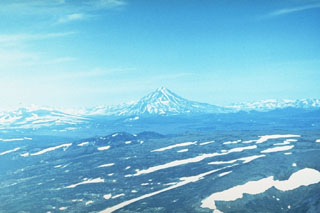Report on Mutnovsky (Russia) — May 2000
Bulletin of the Global Volcanism Network, vol. 25, no. 5 (May 2000)
Managing Editor: Richard Wunderman.
Mutnovsky (Russia) 20 years of fumarolic increases precede 17 March eruption
Please cite this report as:
Global Volcanism Program, 2000. Report on Mutnovsky (Russia) (Wunderman, R., ed.). Bulletin of the Global Volcanism Network, 25:5. Smithsonian Institution. https://doi.org/10.5479/si.GVP.BGVN200005-300060
Mutnovsky
Russia
52.449°N, 158.196°E; summit elev. 2288 m
All times are local (unless otherwise noted)
Two minor phreatic explosions occurred at Mutnovsky on 17 March 2000 (see BGVN 25:04). Subsequent helicopter observations indicated that the eruption took place in the N crater of the volcano. This crater had been active prior to the middle 1950's, but was snow-and-ice filled over the last 20 years. The recent eruption produced small amounts of ash and blocks of altered rocks.
Clearly expressed precursors had provided strong indications that an eruption could be expected. In effect, scientists noted that over the last 20 years the heat output from the main crater increased and was accompanied by the appearance of new fumarolic grounds and an increase in the fumarolic temperature. They also detected a sudden activation of the alpine glacier had started about 5 years ago. Scientists also observed that during the last 5 years, the relative abundance of the chemical elements S/Cl and S/F in the water of Vulcannaya River, which drains the fumarolic fields of the NE and SE craters, increased 3- to 5-fold.
The low magnitude of the 16 March event, the seismicity which continued afterwards for several months, and the relatively long period of preparation may indicate that the explosion is merely a precursor to a stronger eruption in the near future.
Geological Summary. Massive Mutnovsky, one of the most active volcanoes of southern Kamchatka, is formed of four coalescing stratovolcanoes of predominantly basaltic composition. Multiple summit craters cap the volcanic complex. Growth of Mutnovsky IV, the youngest cone, began during the early Holocene. An intracrater cone was constructed along the northern wall of the 1.3-km-wide summit crater. Abundant flank cinder cones were concentrated on the SW side. Holocene activity was characterized by mild-to-moderate phreatic and phreatomagmatic eruptions from the summit crater. Explosive eruptions have been common since the 17th century, with lava flows produced during the 1904 eruption.
Information Contacts: George Gavrilenko, Institute of Volcanology, Far East Division of the Russian Academy of Sciences, Petropavlovsk-Kamchatsky, 683006, Russia; Yuri Taran, Institute of Geophysics, UNAM, Mexico D.F. 04510 Mexico.

